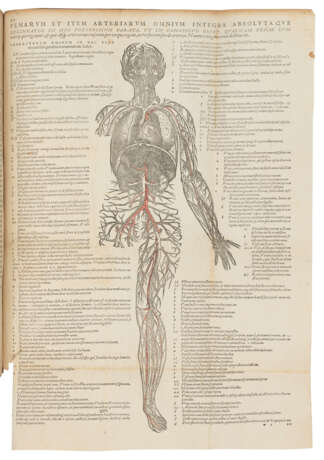ID 794615
Lot 129 | VESALIUS, Andreas (1514-64)
Estimate value
£ 40 000 – 60 000
VESALIUS, Andreas (1514-1564). De humani corporis fabrica libri septem. Basel: Johannes Oporinus, June 1543.
First edition of 'the most famous anatomical work ever published … and the milestone in all medical history’ (Heirs of Hippocrates ). The Fabrica is 'a complete anatomical and physiological study of every part of the human body... [dealing] with bones and muscles, blood vessels, nerves, abdominal viscera, thoracic organs and the brain' (PMM). Benefitting from the then radical practice of dissecting the human body rather than animals, Vesalius broke new ground in his method and observations, thus fundamentally dividing the study of anatomy into pre- and post-Vesalian periods.
The Fabrica combines scientific exposition, art and typography in a manner unprecedented in the 16th century and rarely equalled in later centuries. The more than 200 woodblocks for the illustrations were prepared in Venice by an anonymous artist in the school of Titian under Vesalius's supervision and shipped to the publisher in Basel with the author's precise instructions for placing them in relation to the text and for keying explanations printed in the margins to particular illustrations or details. The woodcuts were highly influential and were re-used or copied for over a century; the woodblocks themselves survived in Germany up to the Second World War. The 14 muscle-men stand in landscapes that together form a panorama of the Euganean Hills near Padua, where Vesalius studied and wrote his magnum opus, and even the woodcut initials, cut specially for this edition, depict activities associated with the dissecting room. The fugitive single leaf in quire m which contains small woodcuts intended to be cut out and attached as overlays to the large folding skeletons, is missing here as in a number of other copies. Adams V-603; Dibner Heralds 122; Garrison-Morton 375; Heirs of Hippocrates 281; Grolier Medicine 18A; NLM/Durling 4577; PMM 71; Wellcome 6560; Norman 2137.
Royal folio (405 x 278mm). Roman, italic, Hebrew and Greek types, two folding sheets following m2 and p3, woodcut pictorial title in first state, author portrait, over 200 woodcut illustrations, including 3 full-page skeletons and 14 full-page muscle-men, one folding sheet and one cut partly coloured, printer's device at end, and many woodcut historiated and ornamental initials from several sets. (Lacking 3 leaves [engraved pictorial title (replaced with ?18th-century letterpress title window-mounted), portrait (supplied in facsimile and mounted), and single leaf ‘Charta parvas aliquot figuras complectens’ usually bound in quire m], folding sheets mounted on verso, a few neat tears without loss, internal tear in b2 repaired affecting a few letters, darkening/staining at some extreme margins with resultant fraying in a few, e4v-5r lightly soiled, few marginal holes in final leaf). 17th-century panelled Dutch vellum over pasteboard. arabesque medallion at centres (evidence of two fore-edge ties, boards detached, spine defective). Provenance: ?18th-century bibliographical note on front pastedown.
Special notice
No VAT on hammer price or buyer's premium.
| Artist: | Andreas Vesalius (1514 - 1564) |
|---|---|
| Auction house category: | Medicine & science, Printed books |
| Artist: | Andreas Vesalius (1514 - 1564) |
|---|---|
| Auction house category: | Medicine & science, Printed books |
| Address of auction |
CHRISTIE'S 8 King Street, St. James's SW1Y 6QT London United Kingdom | |
|---|---|---|
| Preview |
| |
| Phone | +44 (0)20 7839 9060 | |
| Buyer Premium | see on Website | |
| Conditions of purchase | Conditions of purchase |













